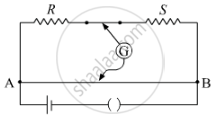Advertisements
Advertisements
Question
In a meter bridge shown in the figure, the balance point is found to be 40 cm from end A. If a resistance of 10 Ω is connected in series with R, balance point is obtained 60 cm from A. Calculate the values of R and S.

Solution
When balance point is at 40 cm, we have
`RS=40/(100−40)=40/60`
`=>R/S=2/3`
`=>3R=2S...........(i)`
When a resistance of 10 Ω is added in series with R,Then, equivalent reistance at R is R′=R+10Now, balance point is at 60 cm.So, we have
`(R+10)/S=60/(100−60)=60/40`
`(R+10)/S=3/2`
⇒2R+20=3S
⇒2R−3S=−20 .....(ii)
Solving (i) and (ii), we get
S=12 Ω
R=8 Ω
APPEARS IN
RELATED QUESTIONS
In potentiometer experiment, if l1 is the balancing length for e.m.f. of cell of internal resistance r and l2 is the balancing length for its terminal potential difference when shunted with resistance R then :
The instrument which can measure terminal potential difference as well as electromotive force (e.m. f.) is ______
- Wheatstone’s meter bridge
- Voltmeter
- Potentiometer
- Galvanometer
State any ‘two’ possible sources of errors in meter-bridge experiment. How can they be minimised?
A cell balances against a length of 200 cm on a potentiometer wire, when it is shunted by a resistance of 8Ω. The balancing length reduces by 40 cm, when it is shunted by a resistance of 4 Ω . Calculate the balancing length when the cell is in open circuit. Also calculate the internal resistance of the cell.
Why is it generally preferred to obtain the balance point in the middle of the meter bridge wire?
Which material is used for the meter bridge wire and why?
An I0m long uniform metallic wire having a resistance of 20Ω IS used as a potentiometer wire. This wire is connected in series with another resistance of 480Ω
and a battery of emf 5V having negligible internal resistance. If an unknown emf e is balanced across 6m of the potentiometer wire, calculate
1) the potential gradient across the potentiometer wire
2) the value of the unknown emf e.
In a meter bridge, the null point is found at a distance of l1 cm from A. If now a resistance of X is connected in parallel with S, the null point occurs at l2 cm. Obtain a formula for X in terms of l1, l2 and S.

The metre bridge works on the principle of ______
A meter bridge is balanced with a known resistance (R) in the left hand gap and an unknown resistance (S) in the right hand gap. Balance point is found to be at a distance of 1 cm from the left hand side. When the battery and the galvanometer are interchanged, balance point will ______.
